
by Deep Green Resistance News Service | Mar 1, 2016 | Indigenous Autonomy, Mining & Drilling
Featured image: The Dongria unanimously rejected the mining project and have vowed to protect the Niyamgiri hills © Bikash Khemka/Survival International
By Survival International
A tribe in eastern India are facing a new threat from mining on their ancestral land, despite having won a major “David & Goliath” legal battle in 2014.
The Dongria Kondh were originally threatened by international mining corporation Vedanta Resources, who tried to open a bauxite mine in their sacred Niyamgiri hills, but were prevented by the Indian Supreme Court, which ruled that the Dongria should decide whether to allow the mine to go ahead.
The tribe unanimously rejected Vedanta’s plans to mine their hills during a historic referendum in which all twelve villages that were consulted voted against the mine.
Now, however, the Odisha state is trying to re-open the issue, petitioning for the right to hold another referendum for the Dongria to pave the way for a large-scale mining operation, this time by state-run Odisha Mining Corporation.
British-owned Vedanta opened a bauxite refinery close to the Dongria’s hills without having secured permission to mine in the area. Even though the mine itself was quashed, the refinery has continued to operate at a loss.
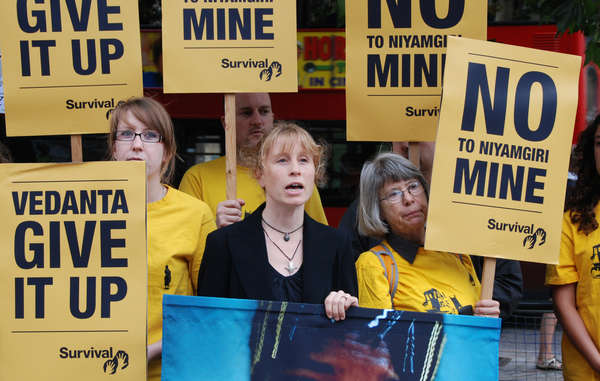
Survival campaigned against Vedanta’s plans and will continue to advocate for the Dongria’s right to protect their sacred hills.
© M. Cowan/Survival International
Despite strong resistance to the project from the Dongria, who have lived in the Niyamgiri hills for generations, the state authorities are keen to keep the refinery open and expand mining operations in the region.
Last year Mukuna Sikaka, a Dongria tribesperson, said: “We are not going to allow mining over Niyamgiri at any cost – not for all the developmental efforts of the government.”
Survival International led a successful global campaign against Vedanta’s plans, and is now calling for the Odisha state authorities to respect the Dongria’s decision to reject the mine.
Survival Director Stephen Corry said: “It is bitterly disappointing to see that the Odisha state authorities have still not learned to respect the wishes of the Dongria Kondh. Tribal peoples have a right under Indian and international law to determine what happens on their lands, yet still governments and corporations insist on putting profits before people’s wishes. Attempts to resume this project after international outcry and stern resistance from the Dongria themselves are not only un-democratic and illegal, but also deeply immoral.”

by Deep Green Resistance News Service | Feb 21, 2016 | Lobbying, Rape Culture
By Jhonathan F. Gómez / Upside Down World
All photos from Supreme Court trial by Jhonathan F. Gómez
Maya Q’eqchi’ women survivors recently entered the Supreme Court in Guatemala as part of the Sepur Zarco case to demand justice for sexual violence, sexual and domestic slavery, forced disappearances and murder, crimes committed during the internal armed conflict of 1960-1996. On February 1, 2016, Army Lieutenant Colonel Francisco Esteelmer Reyes Girón and military commissioner Heriberto Valdés Asij appeared before the court as another historic trial began.
The Sepur Zarco case is representative of the current state of justice for women in Guatemala. It serves as a reminder that the work towards bringing those responsible for genocide and crimes against humanity is an extensive and challenging process anywhere in the world.
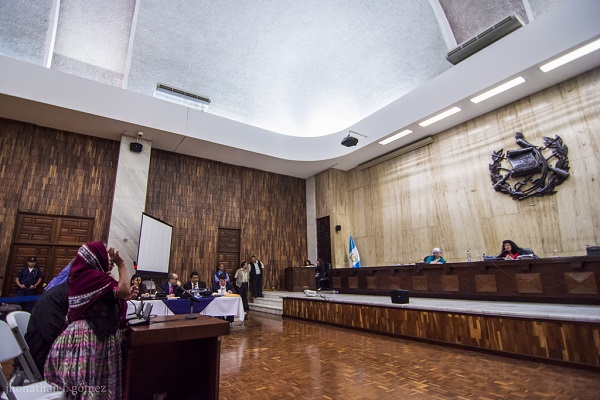
The case goes back to 1982, when the army built a military outpost between the departments of Alta Verapaz and Izabal. Built by forced labor from men of the communities of Panzós and El Estor, it was designated as a resting area for the troops. Late in 1982, the army captured and disappeared Maya Q’eqchi’ men who were fighting for their rights to the land in the area. Consequently, the army took advantage of the widowed women and declared them “alone and available,” forcing them into domestic and sexual slavery. The women were subjected to inhumane conditions, repeatedly raped, gang raped and forced to cook and clean for the army.
These crimes occurred when retired general José Efraín Ríos Mont Ríos Montt was president. Part of his government’s policy was to eliminate the Mayan people by way of displacement, disappearances, murder or forced exile. (Ríos Montt is currently waiting retrial to face justice for his crimes.)

In 1993, the United Nation’s Historical Clarification Commission collected testimonies which allowed for an understanding of what happened. However, a broader understanding of what took place began to surface further in 2000 when the Community Research and Psychosocial Action Team (Equipo de Estudios Comunitarios y Acción Psicosocial, ECAP) conducted psychosocial work with women of the Sepur Zarco region.
The roots of this landmark case are part of a living history which Maya Q’eqchi’ women have been working for years at the community level in the pursuit of justice. In 2009, an independent psychosocial investigation, which led to the publication of a book called Tejidos Que Lleva el Alma (The Weavings that Our Soul Carry) was conducted by ECAP and the National Union of Guatemalan Women (Unión Nacional de Mujeres Guatemaltecas, UNAMG). The book’s aim was to bring the stories of Mayan women survivors into the public consciousness.
In 2010, a symbolic Court of Conscience (Tribunal de Conciencia) against sexual violence for crimes committed during the armed conflict was conducted as a public act by the women survivors. It signaled a breaking of the silence and promoted the sharing of stories with the clear objective that nothing of that nature should ever happen again. The event was organized by various community organizations and with the support of multiple embassies including those from Costa Rica, Spain, Germany Norway and Sweden. Following the symbolic act, the women took a step forward with strategic litigation within the Guatemala justice system.
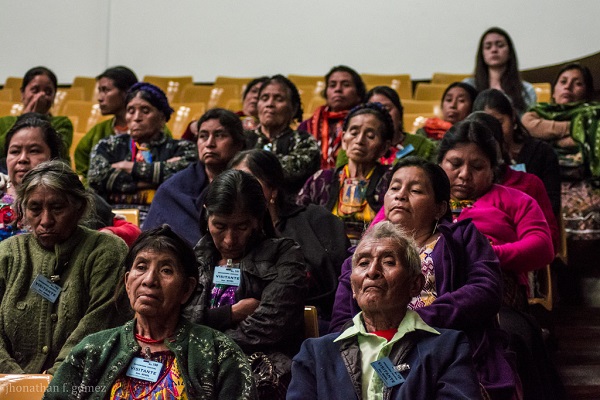
The Breaking the Silence and Impunity Alliance (Alianza Rompiendo el Silencio y la Impunidad), which consists of three grassroots organizations, came together the same year to accompany the legal proceedings of the women survivors. The women survivors have waited over 30 years to see any inclination of justice, and this case can therefore have a large impact in Guatemala and around the world.
The significance of the case cannot be overstated. It is the first time in the world where a national court, in the context of a criminal trial will hear charges against sexual violence during war, as well as the first time a national court will hear charges against sexual and domestic slavery, also in the context of war. The case can set precedents on how sexual violence is judged at a national and international level. Ada I. Valenzuela López from UNAMG states, “In our society, no one else will position sexual violence as an issue in this context. It is a violence which has been silenced for many years. It is almost never at the forefront of any debate in the courts or our society.”
The case stands to move public opinion forward in the struggle for gender justice. It can serve as a step to strengthen trust in a justice system that is capable of hearing the voices of women, and not shaming nor stigmatizing them for speaking out as survivors of sexual violence. It is particularly important for an indigenous population that has been historically discriminated and marginalized to trust in due process. Fifteen women have already testified during the intermediate phase of the case. Many of them have faced threats because of their testimony, yet all of them continue to stand strong because they share a collective understanding of the importance of the trial.
On September 2011, criminal charges were filed in Puerto Barrios, Izabal against military officials Reyes Girón and Valdés Asij. On December, 2011, exhumations were performed at the military outpost. In July of 2012, the prosecutor’s office requested before the Supreme Court that the case be transferred to the High Risk Court. In September of that year, survivors and witnesses presented testimonies before Judge Miguel Ángel Gálvez Aguilar who precedes High Risk Court B.
Arrests were made for Reyes Girón and Valdés Asij in June 14, 2014. On June 23, the first hearing was held and in October, the intermediate phase began which prompted the judge to request a trial date. Immediately after the defense filed a writ of amparo, a legal remedy for the protection of constitutional rights, which was rejected by the Constitutional Court in April of 2015.
In March, April and May of 2015, hearings were suspended because the defense attorneys were not present and because of health problems by Francisco Esteelmer Reyes Girón. Esteelmer Girón had been hospitalized and the defense stated that he was in “poor health.” On June 23, the judge restarted the public debate and the case was sent to the High Risk Court A, comprised by judges Yassmín Barrios, Patricia Bustamante and Gerbi Sical.
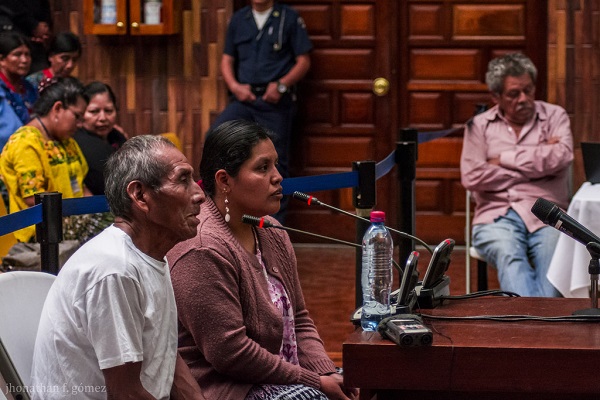
On February 1 of this year, the trial began. It faces many challenges, both in the domain of public opinion, as well as in the trial itself. The defense continues to defame survivors’ organizations, witnesses and uses legal methods to delay the trial. Many organizations have denounced the defense’s methods as a way to evade justice and promote a culture of impunity. Jo-Marie Burt from the Washington Office on Latin America reiterates that “the challenge here is to prove that these types of crimes can be investigated, brought to trial and judged. And to seek to generate mechanism or protocols for the army understand that violence against women cannot be used as an instrument of war, and that women are not war trophies.”
On February 9, the plaintiffs presented over 30 boxes as evidence which contained the remains found in various exhumations which the Forensic Anthropology Foundation of Guatemala (Fundacion de Antropologia Forense de Guatemala, FAFG) conducted. As the contents of the boxes were presented, many people who attended the trial as observers and supporters walked out of the courtroom because of their graphic nature. Evidence of this nature has not always been used at such trials, making it an even more important method of illustrating the magnitude of the crimes.
As a show of support for the Maya Q’eqchi’ women who will be testifying, women from various regions across the country have been present through the trial. As the country watches another historic trial unfold, the survivors are clear on their position. They seek justice and will not rest in peace until justice is served. They want to bring the issue of sexual violence into the public conversation and to show that it is hard for women to speak out against this type of violence. They want their voices to be heard, their truth to be known. They want society to understand that what happened to them was not their fault, and most importantly, that no other woman in Guatemala, or anywhere in the world, experiences what they lived through.
Jhonathan F. Gómez, is a documentary photographer currently living in Guatemala City. He is commitment to documenting the subaltern and diasporic realities of Guatemala as they relate to historic memory, race, class, gender, sexuality, identity and justice.
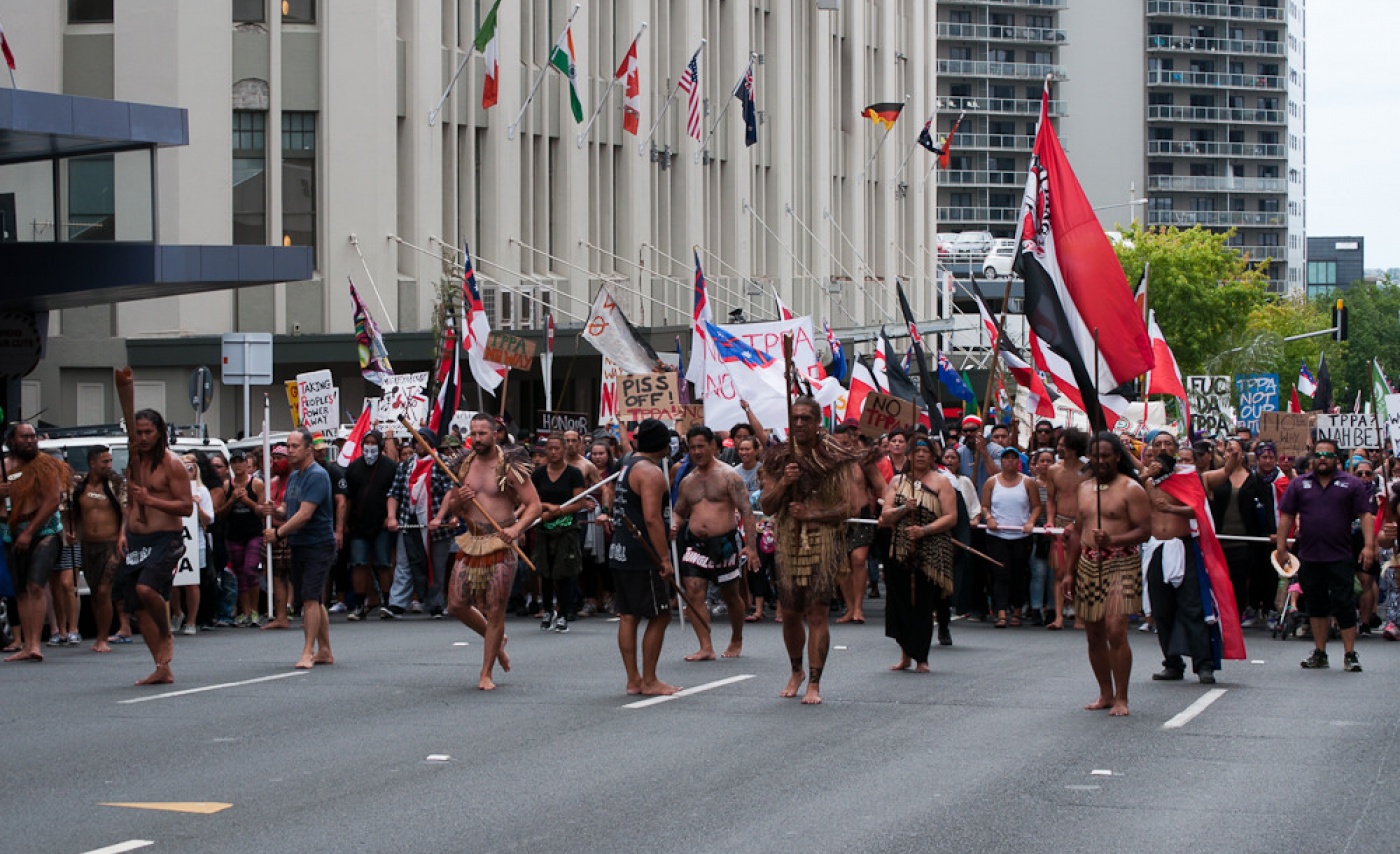
by Deep Green Resistance News Service | Feb 19, 2016 | Colonialism & Conquest, Indigenous Autonomy
Featured image: Maori protests on February 4th signing of the TPP in Auckland, New Zealand. Photo by Dominic Hartnett
By Cultural Survival
The Trans-Pacific Partnership agreement, if approved, would be the largest trade agreement in history involving 11 countries including the United States, Australia, Brunei, Canada, Chile, Japan, Malaysia, Mexico, New Zealand, Peru, Singapore, and Vietnam.
Cultural Survival staff caught up with the United Nations Special Rapporteur on the Rights of Indigenous Peoples, Victoria Tauli-Corpuz, to discuss the trade deal’s implications for Indigenous Peoples in these countries, based on her recent research and report on this topic.
Vicky Tauli-Corpuz explains that the TPP agreement is about liberalizing the trade and investment regime in order to allow for more fluidity when trading among countries. However, she shared her concern that in this agreement investor’s rights may be more protected than the rights of the Indigenous Peoples; the investment clause would trump social and environmental rights, including human rights.
“You cannot have a situation where investor’s rights are more protected than Indigenous rights,” she explained.
Ms. Tauli-Corpuz also used the example of Bolivia, where the government had listened and acted upon Indigenous protests against a Canadian mine on their lands, by attempting to cancel the concession. Bolivia was then sued by the Canadian corporation that owned the mine. The mining corporation won and the Bolivian government was left to pay millions of dollars to the company for lost profits. She noted that most developing countries lose in arbitration with corporations because they simply do not have the lawyers to support them. Corpuz warned, these are the types of situations that occur when investors are prioritized over the local and Indigenous citizens.
The TPP was negotiated in secret, and its text was only released via Wikileaks until it was already negotiated by trade ministers of the respective countries. According to Tauli Corpuz, this secrecy is a violation of Indigenous Peoples right to Free, Prior, Informed Consent on policies that may affect them.
“In situations where Indigenous Peoples have the right to Free, Prior, Informed Consent before any company comes to their community to invest, that kind of right has to be respected and that has to be stated and pursued by the countries who are hosting this investment,” she warned.
She urges for deeper transparency in trade deals like the TPP, so that Indigenous Peoples can be aware of the content of these trade agreements so that they can participate and decide whether or not to consent. In order to achieve this there must be a call to action to create a more participatory negotiation process rather than the exclusive and secretive one that has occurred. If the TPP is passed within each country’s legislature, it would deregulate social standards that are put in place and can take states themselves to court for attempting to protect social conducts such as protecting the rights of Indigenous Peoples.
The Special Rapporteur also recommends that extra attention be made to Exceptions section of the trade agreement. For example, specifically naming FPIC and Indigenous Peoples rights in the stipulations of how the the trade agreement would play out within each country. It is the responsibility of each country to identify and present exceptions so that they can be held accountable during arbitration panels. For example, New Zealand did manage to include an exception in TPP article 29.6 that references the rights of the Maori people, however activists have argued that the wording of the exception allows too many loopholes to provide legitimate protection.
On February 4th, 2016, the TPP was signed by trade ministers of 11 countries, in a formal ceremony in New Zealand. But the deal must still be approved within the legislatures of each country for it to be put in place: The TPP will not come into effect until a requisite number of original signatories ratify the agreement.
Maori leaders in New Zealand held massive protests against the signing ceremony, saying that they do not give their consent to the deal and that the it violates the Treaty of Waitangi and the 1835 Declaration of Independence of New Zealand. Kingi Taurua, a prominent Nga Puhi elder at Waitangi’s Te Tii Marae, has sent a formal notice of veto of the Trans-Pacific Partnership agreement to the embassies and trade departments of its proposed partner countries. They argued that the New Zealand government does not have “due authority” to sign the TPP without the agreement of Maori elders, “which [agreement] has not been given.”
In the United States, the next step is the drafting and consideration of a bill in Congress to implement the agreement, which will also serve as U.S. ratification of the international trade deal. Some anticipate this vote to take place after the 2016 elections in November.
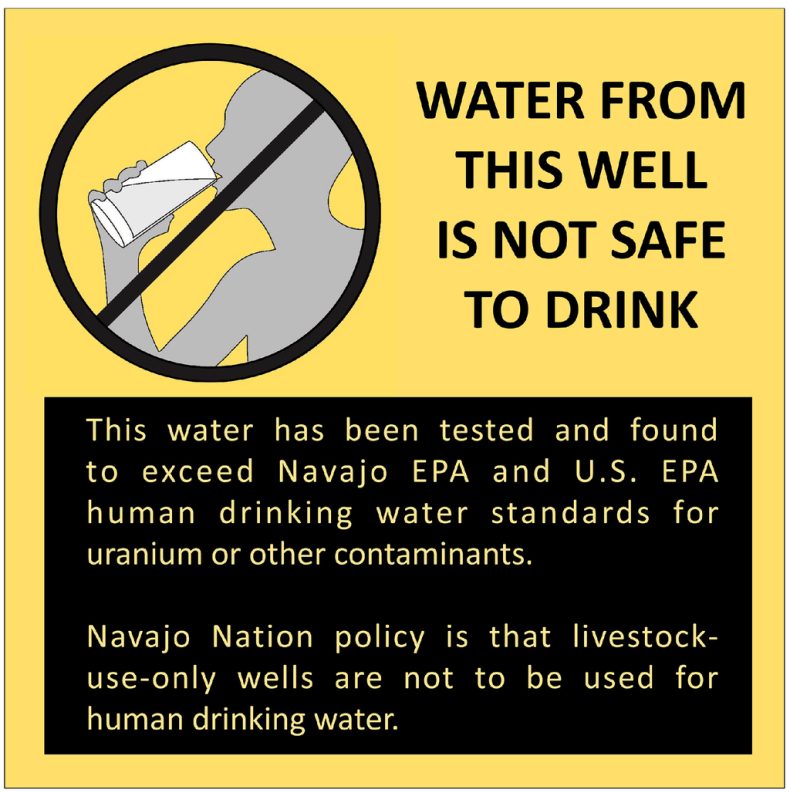
by Deep Green Resistance News Service | Feb 11, 2016 | Colonialism & Conquest, Toxification
Featured image: Figure from EPA Pacific Southwest Region 9 Addressing Uranium Contamination on the Navajo Nation
By Courtney Parker / Intercontinental Cry
Recent media coverage and spiraling public outrage over the water crisis in Flint, Michigan has completely eclipsed the ongoing environmental justice struggles of the Navajo. Even worse, the media continues to frame the situation in Flint as some sort of isolated incident. It is not. Rather, it is symptomatic of a much wider and deeper problem of environmental racism in the United States.
The history of uranium mining on Navajo (Diné) land is forever intertwined with the history of the military industrial complex. In 2002, the American Journal of Public Health ran an article entitled, “The History of Uranium Mining and the Navajo People.” Head investigators for the piece, Brugge and Gobel, framed the issue as a “tradeoff between national security and the environmental health of workers and communities.” The national history of mining for uranium ore originated in the late 1940’s when the United States decided that it was time to cut away its dependence on imported uranium. Over the next 40 years, some 4 million tons of uranium ore would be extracted from the Navajo’s territory, most of it fueling the Cold War nuclear arms race.
Situated by colonialist policies on the very margins of U.S. society, the Navajo didn’t have much choice but to seek work in the mines that started to appear following the discovery of uranium deposits on their territory. Over the years, more than 1300 uranium mines were established. When the Cold War came to an end, the mines were abandoned; but the Navajo’s struggle had just begun.
Back then, few Navajo spoke enough English to be informed about the inherent dangers of uranium exposure. The book Memories Come to Us in the Rain and the Wind: Oral Histories and Photographs of Navajo Uranium Miners and Their Families explains how the Navajo had no word for “radiation” and were cut off from more general public knowledge through language and educational barriers, and geography.
The Navajo began receiving federal health care during their confinement at Bosque Redondo in 1863. The Treaty of 1868 between the Navajos and the U.S. government was made in the good faith that the government – more specifically, the Bureau of Indian Affairs (BIA) – would take some responsibility in protecting the health of the Navajo nation. Instead, as noted in “White Man’s Medicine: The Navajo and Government Doctors, 1863-1955,” those pioneering the spirit of western medicine spent more time displacing traditional Navajo healers and knowledge banks, and much less time protecting Navajo public health. This obtuse, and ultimately short-sighted, attitude of disrespect towards Navajo healers began to shift in the late 1930’s; yet significant damage had already been done.
Founding director of the environmental cancer section of the National Cancer Institute (NCI), Wilhelm C. Hueper, published a report in 1942 that tied radon gas exposure to higher incidence rates of lung cancer. He was careful to eliminate other occupational variables (like exposure to other toxins on the job) and potentially confounding, non-occupational variables (like smoking). After the Atomic Energy Commission (AEC) was made aware of his findings, Hueper was prohibited from speaking in public about his research; and he was reportedly even barred from traveling west of the Mississippi – lest he leak any information to at-risk populations like the Navajo.
In 1950, the U.S. Public Health Service (USPHS) began to study the relationship between the toxins from uranium mining and lung cancer; however, they failed to properly disseminate their findings to the Navajo population. They also failed to properly acquire informed consent from the Navajos involved in the studies, which would have required informing them of previously identified and/or suspected health risks associated with working in or living near the mines. In 1955, the federal responsibility and role in Navajo healthcare was transferred from the BIA to the USPHS.
In the 1960’s, as the incidence rates of lung cancer began to climb, Navajos began to organize. A group of Navajo widows gathered together to discuss the deaths of their miner husbands; this grew into a movement steeped in science and politics that eventually brought about the Radiation Exposure Compensation Act (RECA) in 1999.
Cut to the present day. According to the US EPA, more than 500 of the existing 1300 abandoned uranium mines (AUM) on Navajo lands exhibit elevated levels of radiation.
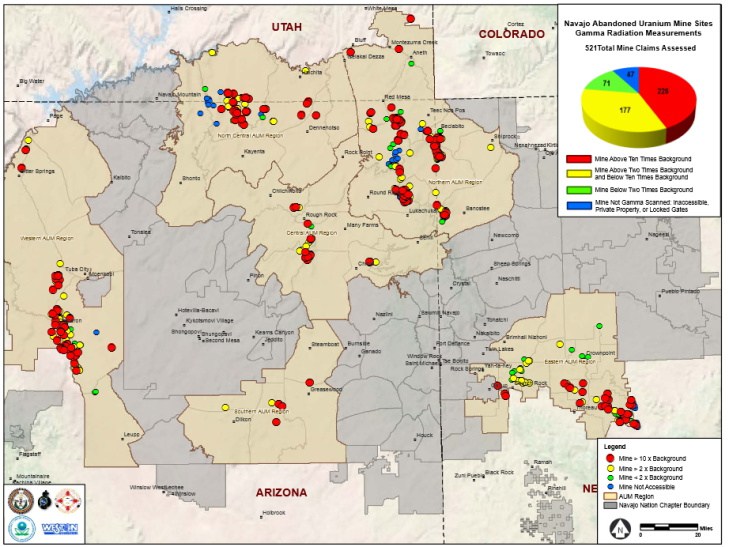
Navajo abandoned uranium mines gamma radiation measurements and priority mines. US EPA
The Los Angeles Times gave us a sense of the risk in 1986. Thomas Payne, an environmental health officer from Indian Health Services, accompanied by a National Park Service ranger, took water samples from 48 sites in Navajo territory. The group of samples showed uranium levels in wells as high as 139 picocuries per liter. Levels In abandoned pits were far more dangerous, sometimes exceeding 4,000 picocuries. The EPA limit for safe drinking water is 20 picocuries per liter.
This unresolved plague of radiation is compounded by pollution from coal mines and a coal-fired power plant that manifests at an even more systemic level; the entire Navajo water supply is currently tainted with industry toxins.
Recent media coverage and spiraling public outrage over the water crisis in Flint, Michigan has completely eclipsed the ongoing environmental justice struggles of the Navajo. Even worse, the media continues to frame the situation in Flint as some sort of isolated incident.
Madeline Stano, attorney for the Center on Race, Poverty & the Environment, assessed the situation for the San Diego Free Press, commenting, “Unfortunately, Flint’s water scandal is a symptom of a much larger disease. It’s far from an isolated incidence, in the history of Michigan itself and in the country writ large.”
Other instances of criminally negligent environmental pollution in the United States include the 50-year legacy of PCB contamination at the Mohawk community of Akwesasne, and the Hanford Nuclear Reservation (HNR) situated in the Yakama Nation’s “front yard.”
While many environmental movements are fighting to establish proper regulation of pollutants at state, federal, and even international levels, these four cases are representative of a pervasive, environmental racism that stacks up against communities like the Navajo and prevents them from receiving equal protection under existing regulations and policies.
Despite the common thread among these cases, the wave of righteous indignation over the ongoing tragedy in Flint has yet to reach the Navajo Nation, the Mohawk community of Akwesasne, the Yakama Nation – or the many other Indigenous communities across the United States that continue to endure various toxic legacies in relative silence.
Current public outcry may be a harbinger, however, of an environmental justice movement ready to galvanize itself towards a higher calling, one that includes all peoples across the United States, and truly shares the ongoing, collective environmental victories with all communities of color.
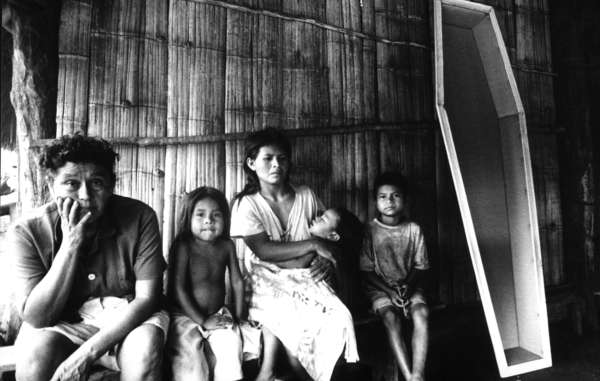
by Deep Green Resistance News Service | Feb 9, 2016 | Alienation & Mental Health, Colonialism & Conquest
Featured image: A bereaved Guarani family waiting beside a coffin. The wave of suicides that has struck the Guarani Indians in the last 20 years is unequalled in South America. Suicide is often seen as the only option by people forced from their land and into a way of life they did not choose. Photo © João Ripper/Survival
By Survival International
A new report published by Survival International reveals that the appalling suicide rate among the indigenous Guarani Kaiowá people of southern Brazil is the highest in the world.
The rate of self-inflicted deaths within the tribe is 34 times the Brazilian national average, and statistically the highest among any society anywhere on earth. Suicide rates among many other indigenous peoples such as Aboriginal Australians and Native Americans in Alaska also remain exceptionally high. This can be viewed as the inevitable result of the historical and continuing theft of their land and of “development” being forced upon them.
The report, “Progress can Kill,” exposes the devastating consequences of loss of land and autonomy on tribal peoples. As well as the shockingly high suicide rates among tribes, it also reveals high rates of alcoholism, obesity, depression and other health problems.
Particularly striking statistics include the sky-rocketing rates of HIV infection in West Papua, which increased from almost no cases in 2000 to over 10,000 by 2015, and the rate of infant mortality among Aboriginal Australians – twice that in wider Australian society. In large parts of the world, poor nutrition continues to cause further problems, such as malnutrition for Guarani children in Brazil, who are forced to live on roadsides, and obesity for many Native Americans, for whom junk food is the only viable option.
Roy Sesana of the Botswana Bushmen, forcibly evicted from their land in 2002, said: “What kind of development is this when the people lead shorter lives than before? They catch HIV/AIDS. Our children are beaten in school and won’t go. Some become prostitutes. We are not allowed to hunt. They fight because they are bored and get drunk. They are starting to commit suicide. We never saw this before. Is this ‘development?’”

Many Aché starved to death after being forced from their forest home in Paraguay
© Don McCullin/Survival
Olimpio, of the Guajajara tribe in the Brazilian Amazon, said: “We are against the type of development the government is proposing. I think some non-Indians’ idea of ‘progress’ is crazy! They come with these aggressive ideas of progress and impose them on us, human beings, especially on indigenous peoples who are the most oppressed of all. For us, this is not progress at all.”
All of these statistics demonstrate the fatal consequences of forcing change on tribal societies in the name of “progress” and “development.” In many cases, tribes have been forced to move away from abundant and sustainable food sources and a sure source of identity in favour of poverty and marginalization on the fringes of mainstream society. Tragic repercussions of such forced change can continue even several generations down the line.
Around the world, tribes continue to fight for the recognition of their right to live on their lands in peace. Where this right has been respected or restored, tribes flourish. For example after the creation of an indigenous reserve in the northern Amazon in 1992, medical teams worked with tribal shamans and together they halved the mortality rate among the Yanomami Indians. Likewise, the Jarawa In India live on their ancestral lands and enjoy what has been called a “life of opulence.” Nutrionists rate their diet as “optimum.”
For more information you can download Survival’s new short report, “Progress can kill,” and a more in-depth paper for those wanting to know more.
Around the world development is robbing tribal people of their land, self-sufficiency and pride and leaving them with nothing. Watch this short, satirical film, written by Oren Ginzburg and narrated by actor and comedian David Mitchell, which tells the story of how tribal peoples are being destroyed in the name of “development.”
Survival International, the global movement for tribal peoples’ rights, is calling for the United Nations to enforce better protection of tribal land rights and to call on governments to uphold their commitments to their indigenous peoples.












